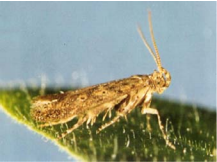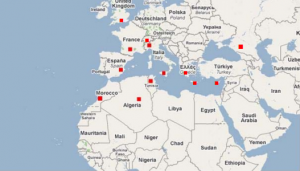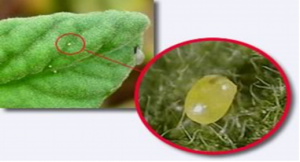Tomato leaf gallery moth, Tuta absoluta (Lepidoptera:
Gelechiidae) is a very important pest of tomatoes. tomato
larvae that feed on all parts of the plant
cause damage. Large larvae on leaves
open galleries, stalk inside, end buds, green and mature
they open galleries in fruits. Tuta absoluta 80-100%
product loss. Main host of the pest
tomatoes, potatoes, eggplants, peppers and
solanacea family also harms the weeds.
 Geographical Extension
Geographical Extension
Tuta absoluta is a pest known since 1970 in many South American countries. Record, Tuta
absoluta are found in various parts of Europe and the Mediterranean Sea. Pest, Mediterranean city
The future of tomato production is seriously threatening. Tuta absoluta‘s settings for the first time
At the end of 2006, it was published in tomato plants in Spain. In 2008, Tuta absoluta France,
It has been detected in many parts of Algeria and Morocco. In 2009, the status of this pest France, Italy, Tunisia and
It was officially announced in Malta. The pest is spreading very quickly in the Mediterranean. Appropriate
can reproduce very quickly in agro-ecological environments. And once checked in, it’s checked
it is quite difficult.

Biology
The adults are 5-7 mm long and the wingspan is 8-10 mm. Adult’s antennae are thread-shaped
(such as the bead string) is an important feature in the diagnosis. Females up to 250 in their lifetime
egg market. Eggs are small cylindrical in creamy white with yellow color and 0.35 mm
long. Tuta absoluta eggs according to the lower surface of natural leaves or the outside.
Eggs are released after 4-6 days. The larva is cream-colored and has a typical black head. Four
larval period. Larval period 10-15 days. Pupa is brown in color. In the soil, in the plant
It enters the pupal phase in the galleries and is completed within 10 days. In the front wings of the adult
silvery gray scales and characteristic black dots. A progeny within 30–40 days
Complete. Tuta absoluta has high reproductive potential. Larvae are nutrients in a diaposa
It does not enter the (period of stagnation). You can dump up to 12 per year. Adults are active at night and during the day
They were hiding years ago. Spends the winter as a harmful egg, pupal or adult.
For adults, thread-shaped antennas (like string of beads), silvery-gray scales on the front wings and
characteristic black dots are important diagnostic characters.

Important determinant
Adult: Yarn-shaped antennas (such as string of beads), silvery-gray scales on the front wings and
characteristic black spots.
Silvery-gray scales and characteristic black spots on the front wing
See moth picture.


Damage Type
The potential for damage to Tuta absoluta in tomato cultivation in greenhouses, undergrowth and outdoors
It is high. Tuta absoluta attacks, feeds and develops all parts of the plant above ground.
Larvae are fed between the layers of epidermis in the leaves to form irregular galleries and
it can then cause the plant to die. Fruits are attacked as they begin to form
Secondary pathogens causing fruit decay
can be infected by. This damages the tomato’s growth process, while being shipped and processing
increasingly can still be seen. The damage can find 100% whether the violence is taken or not.
Struggle with Tuta absoluta
The resistance of Tuta absoluta to chemical drugs, which must be defined beforehand, decreases
developed. Processes in South America have shown that synthetic insecticides have failed.
shows. In addition, the galleries they opened also allow the larvae to come into contact with insecticides with
It hampers. On the other hand, chemical drugs kill natural predators and parasitoids, health
and environmental risks
restrictions. Hurry to alternative methods
is desired. Solutions with each other
pheromone use.

